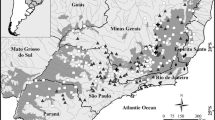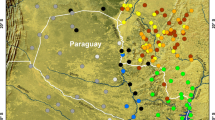Abstract
The Brazilian Atlantic Forest (sensu lato) is constituted by Dense Ombrophilous Forest, Mixed Ombrophilous Forest and Seasonal Semideciduous Forest, in which tree species are distributed in gradients, whichever latitude, longitude, or altitude is considered. We investigated whether herb species living on the floor of these forests would have the same geographic distribution pattern. If tree and herb-layer species have coincident distribution patterns, the same conservation units can conserve both species sets; otherwise, specific conservation actions should be taken. We built a presence/absence matrix of 803 terrestrial native species in 80 surveys across the southern and southeastern Brazilian Atlantic Forest. We performed UPGMA, CA and RDA multivariate analyses in order to investigate the distribution patterns. The high degree of agreement among the analyses led us to assume that the geographic distribution of the herb-layer flora occurs as gradients among three main floristic groups: Tropical Ombrophilous forests (mostly lowland forests), Subtropical Ombrophilous forests (mostly montane and upper-montane forests in lower latitudes and sub-montane and lowland forests in higher latitudes, i.e., where temperature is lower), and Seasonal Semideciduous forests (with a marked dry season). Based on different patterns and processes between herbs and trees, and in order to encompass the highest flora diversity, we highlight the importance of creating more reserves in each one of the three main floristic groups of herb-layer species in the Brazilian Atlantic Forest.





Similar content being viewed by others
References
APG III (2009) An update of the angiosperm phylogeny group classification for the orders and families of flowering plants. Bot J Linn Soc 161:105–121
Behling H (1998) Late Quaternary vegetational and climatic changes in Brazil. Rev Palaeobot Palynol 99:143–156. doi:10.1016/s0034-6667(97)00044-4
Behling H (2002) South and southeast Brazilian grasslands during Late Quaternary times: a synthesis. Palaeogeogr Palaeoclimatol Palaeoecol 177:19–27
Behling H, Lichte M (1997) Evidence of dry and cold climatic conditions at glacial times in tropical SE Brazil. Quat Res 48:348–358
Behling H, Pillar V, Bauermann S (2005) Late Quaternary grassland (Campos), gallery forest, fire and climate dynamics, studied by pollen, charcoal and multivariate analysis of the São Francisco de Assis core in western Rio Grande do Sul (southern Brazil). Rev Palaeobot Palynol 133:235–248. doi:10.1016/j.revpalbo.2004.10.004
Bertoncello R, Yamamoto K, Meireles LD, Shepherd GJ (2011) A phytogeographic analysis of cloud forests and other forest subtypes amidst the Atlantic forests in south and southeast Brazil. Biodivers Conserv 20:3413–3433. doi:10.1007/s10531-011-0129-6
Borcard D, Gillet F, Legendre P (2011) Numerical ecology with R. Use R! Series. Springer, New York
Cáceres MD, Legendre P (2009) Associations between species and groups of sites: indices and statistical inference. Ecology 90:3566–3574. doi:10.1890/08-1823.1
Caiafa AN, Martins FR (2007) Taxonomic identification, sampling methods, and minimum size of the tree sampled: implications and perspectives for studies in the Brazilian Atlantic Rainforest. Funct Ecosyst Commun 1:95–104
Carvalho GH, Cianciaruso MV, Batalha MA (2010) Plantminer: a web tool for checking and gathering plant species taxonomic information. Environ Model Softw 25:815–816. doi:10.1016/j.envsoft.2009.11.014
Cestaro LA, Waechter JL, Baptista LRM (1986) Fitossociologia do estrato herbáceo da mata de Araucária da Estação Ecológica de Aracuri. Esmeralda, Rio Grande do Sul Hoehnea 13:59–72
Chazdon RL, Pearcy RW (1991) The importance of sunflecks for forest understory plants. Bioscience 41:760–766
Chazdon R, Pearcy R, Lee D, Fetcher N (1996) Photosynthetic responses of tropical forest plants to contrasting light environments. In: Mulkey S, Chazdon R, Smith A (eds) Tropical forest plant ecophysiology. Springer, New York, pp 5–55. doi:10.1007/978-1-4613-1163-8_1
De Cáceres M, Legendre P, Wiser SK, Brotons L, O’Hara RB (2012) Using species combinations in indicator value analyses. Methods Ecol Evol 3:973–982. doi:10.1111/j.2041-210X.2012.00246.x
Dormann CF et al (2013) Collinearity: a review of methods to deal with it and a simulation study evaluating their performance. Ecography 36:27–46. doi:10.1111/j.1600-0587.2012.07348.x
Dufrene M, Legendre P (1997) Species assemblages and indicator species: the need for a flexible asymmetrical approach. Ecol Monogr 67:345–366
Eisenlohr PV (2014) Persisting challenges in multiple models: a note on commonly unnoticed issues regarding collinearity and spatial structure of ecological data Brazilian. J Bot 37:365–371. doi:10.1007/s40415-014-0064-3
ESRI (2010) ArcGIS 10.0. Environmental Systems Research Institute Inc, Redlands
Falkenberg DB (2003) Matinhas nebulares e vegetação rupicola dos Aparados da Serra Geral (SCRS), sul do Brasil. PhD, University of Campinas
Felfili JM, Eisenlohr PV, Melo MMRF, Andrade IA, Meira-Neto JAA (2011) Fitossociologia no Brasil: Métodos e Estudos de Casos, vol 1. Editora UFV, Viçosa
Forzza RC et al (2010) Lista de Espécies da Flora do Brasil. Jardim Botânico do Rio de Janeiro, Rio de Janeiro
Gauch HG Jr (1982) Multivariate analysis in community ecology. Cambridge University Press, Cambridge
Gentry AH, Dodson C (1987) Contribution of non-trees to species richness of a tropical rain forest. Biotropica 19:149–156
Gonzaga APD, Oliveira-Filho AT, Machado ELM, Hargreaves P, Machado JNM (2008) Diagnóstico florístico-estrutural do componente arbóreo da floresta da Serra de São José, Tiradentes, MG, Brasil. Acta Bot Bras 22:505–520
Hamrick JL, Godt MJW (1996) Effects of life history traits on genetic diversity in plant species. Philos Trans R Soc Lond B Biol Sci 351:1291–1298
Hijmans RJ, Cameron SE, Parra JL, Jones PG, Jarvis A (2005) Very high resolution interpolated climate surfaces for global land areas. Int J Climatol 25:1965–1978. doi:10.1002/joc.1276
Hill MO (1973) Reciprocal averaging: an eigenvector method or ordination. J Ecol 61:237–249
IBGE (2012) Manual técnico da vegetação brasileira, 2ª edn. Fundação Instituto Brasileiro de Geografia e Estatística - IBGE, Rio de Janeiro
Ivanauskas NM, Monteiro R, Rodrigues RR (2000) Similaridade florística entre áreas de floresta atlântica no estado de São Paulo Brazilian. J Ecol 1–2:71–81
Jaramillo-Correa JP, Verdu M, Gonzalez-Martinez SC (2010) The contribution of recombination to heterozygosity differs among plant evolutionary lineages and life-forms. BMC Evol Biol 10:22. doi:10.1186/1471-2148-10-22
Legendre P, Gallagher E (2001) Ecologically meaningful transformations for ordination of species data. Oecologia 129:271–280. doi:10.1007/s004420100716
Legendre P, Legendre L (1998) Numerical ecology. Elsevier, Amsterdam
Levin DA, Wilson AC (1976) Rates of evolution in seed plants: net increase in diversity of chromosome numbers and species numbers through time. Proc Natl Acad Sci USA 73:2086–2090
Margules CR, Pressey RL (2000) Systematic conservation planning. Nature 405:243–253
Margules C, Pressey R, Williams P (2002) Representing biodiversity: data and procedures for identifying priority areas for conservation. J Biosci 27:309–326. doi:10.1007/bf02704962
McCune B (1997) Influence of noisy environmental data on canonical correspondence analysis. Ecology 78:2617–2623
Mulkey SS, Smith AP, Wright SJ (1991) Comparative life history and physiology of two understory neotropical herbs. Oecologia 88:263–273
Oksanen J et al. (2014) vegan: Community Ecology Package. R package version 2.0-10, edn. http://CRAN.R-project.org/package=vegan. Accessed 12 Sept 2014
Oliveira RJ (2006) Variação da composição florística e da diversidade alfa das florestas atlânticas no estado de São Paulo. University of Campinas, Campinas
Oliveira-Filho AT, Fontes MAL (2000) Patterns of floristic differentiation among Atlantic Forests in Southeastern Brazil and the influence of climate. Biotropica 32:793–810. doi:10.1111/j.1744-7429.2000.tb00619.x
Oliveira-Filho AT et al (2005) Análise florística do compartimento arbóreo de áreas de Floresta Atlântica sensu lato na região das bacias do leste (Bahia, Minas Gerais, Espírito Santo e Rio de Janeiro). Rodriguésia 56:185–235
Oliveira-Filho AT, Jarenkow JA, Rodal MJN (2006) Floristic relationships of seasonally dry forests of eastern South America based on tree species distribution patterns. In: Pennington RT, Lewis GP, Ratter JA (eds) Neotropical savannas and seasonally dry forests: plant diversity, biogeography, and conservation. CRC Press, New York, pp 159–192
Palmer MW (1993) Putting things in even better order: the advantages of canonical correspondence analysis. Ecology 74:2215–2230
Pearcy RW (1983) The light environment and growth of C3 and C4 tree species in the understory of a Hawaiian forest. Oecologia 58:19–25. doi:10.1007/bf00384537
Petit RJ, Hampe A (2006) Some evolutionary consequences of being a tree. Annu Rev Ecol Syst 37:187–214. doi:10.1146/annurev.ecolsys.37.091305.110215
R Development Core Team (2014) R: a language and environment for statistical computing, 3.1.1 edn. R Foundation for Statistical Computing, Vienna
Raich JW (1989) Seasonal and spatial variation in the light environment in a tropical dipterocarp forest and gaps. Biotropica 21:299–302
Rao CR (1964) The use and interpretation of principal component analysis in applied research Sankhya. Indian J Stat Ser A 26:329–358
Ribeiro MC, Metzger JP, Martensen AC, Ponzoni FJ, Hirota MM (2009) The Brazilian Atlantic Forest: how much is left, and how is the remaining forest distributed? Implications for conservation. Biol Conserv 142:1141–1153
Ribeiro TM, Ivanauskas NM, Martins SV, Polisel RT, Santos RLRd, Miranda Neto A (2013) Mixed rain forest in southeastern Brazil: tree species regeneration and floristic relationships in a remaining stretch of forest near the city of Itaberá. Brazil Acta Bot Bras 27:71–86
Richards PW (1996) The tropical rain forest: an ecological study. Cambridge University Press, Cambridge
Salis SM, Shepherd GJ, Joly CA (1995) Floristic comparison of mesophytic semideciduous forests of the interior of the state of São Paulo. Southeast Brazil Vegetatio 119:155–164
Schaich H, Milad M (2013) Forest biodiversity in a changing climate: which logic for conservation strategies? Biodivers Conserv 22:1107–1114. doi:10.1007/s10531-013-0491-7
Scudeller VV, Martins FR, Shepherd GJ (2001) Distribution and abundance of arboreal species in the Atlantic ombrophilous dense forest in southeastern Brazil. Plant Ecol 152:185–199
Smith SA, Donoghue MJ (2008) Rates of molecular evolution are linked to life history in flowering plants. Science 322:86–89. doi:10.1126/science.1163197
Smith AR, Pryer KM, Schuettpelz E, Korall P, Schneider H, Wolf PG (2006) A classification for extant ferns Taxon 55:705–731
Souza RPM (2009) Estrutura da comunidade arbórea de trechos de florestas de Araucaria no estado de São Paulo, Brasil. Escola Superior de Agricultura Luiz de Queiroz - ESALQ/USP
ter Braak CJF (1995) Ordination. In: Jongmann RHG, ter Braak CJF, van Tangeren ORF (eds) Data analysis in community and landscape ecology. Cambridge University Press, Cambridge, pp 91–173
Torres RB, Martins FR, Kinoshita LS (1997) Climate, soil and tree flora relationships in forests in the state of São Paulo, southeastern Brazil. Rev Bras Bot 20:41–49
Tropicos.org (2011) Missouri Botanical Garden http://www.tropicos.org/. Accessed 2010–2011
Verdú M (2002) Age at maturity and diversification in woddy angiosperms. Evolution 56:1352–1361. doi:10.1111/j.0014-3820.2002.tb01449.x
Walther G-R et al (2002) Ecological responses to recent climate change. Nature 416:389–395
Wartenberg D, Ferson S, Rohlf FJ (1987) Putting things in order: a critique of detrended correspondence analysis. Am Nat 129:434–448
Yamamoto LF, Kinoshita LS, Martins FR (2005) Florística dos componentes arbóreo e arbustivo de um trecho da Floresta Estacional Semidecídua Montana, município de Pedreira, estado de São Paulo. Rev Bras Bot 28:191–202
Zuur AF, Ieno EN, Elphick CS (2010) A protocol for data exploration to avoid common statistical problems. Methods Ecol Evol 1:3–14. doi:10.1111/j.2041-210X.2009.00001.x
Acknowledgments
We thank CAPES (Coordenação de Aperfeiçoamento de Pessoal de Nível Superior) for the Doctorate and Master scholarships granted to the first and second authors. The authors are grateful to the São Paulo Research Foundations (FAPESP Grant #2001/05146-6) and Brazilian Council for Research and Technologic Development (CNPq Grant #479084/2007-6) for financial support. We also thank Pedro V. Eisenlohr and Ary Teixeira de Oliveira-Filho for the invitation to this special issue.
Author information
Authors and Affiliations
Corresponding author
Additional information
Communicated by Jefferson Prado, Pedro V. Eisenlohr and Ary T. de Oliveira-Filho.
Electronic supplementary material
Below is the link to the electronic supplementary material.
10531_2015_967_MOESM2_ESM.xls
Supplementary material 2 (XLS 223 kb). Appendix 2: Floristic matrix with 73 sites as objects and 368 species as descriptors
10531_2015_967_MOESM3_ESM.xls
Supplementary material 3 (XLS 36 kb). Appendix 3: Environmental matrix with 73 sites and 10 environmental variables from WorldClim 1.4 database (Hijmans et al. 2005)
Rights and permissions
About this article
Cite this article
Vieira, L.T.A., Polisel, R.T., Ivanauskas, N.M. et al. Geographical patterns of terrestrial herbs: a new component in planning the conservation of the Brazilian Atlantic Forest. Biodivers Conserv 24, 2181–2198 (2015). https://doi.org/10.1007/s10531-015-0967-8
Received:
Revised:
Accepted:
Published:
Issue Date:
DOI: https://doi.org/10.1007/s10531-015-0967-8




